Now that the dust has settled and the new European Parliament (EP) is seated, I thought we could look at where we stand and where we come from. If you are not familiar with the messy EU parliamentary politics, then we should start at the beginning.
(Ablated) Introduction to EU politics
In 1979, the EP became the first, and thus far the only, EU institution whose members (known as Members of the European Parliament or MEPs) are elected directly by the people.1 There are three levels of affiliation for MEPs: they can belong to a national party, to a European party and to a European parliamentary group.
If you are a European citizen voting in the EU elections, the choices before you should have familiar names: they tend to be the same parties/politicians you would vote for in local and/or national elections. Usually, these national parties will have formed European parties (alone or in coalition) and if elected to the EP they will usually try to form or join blocs known as "groups." For example, Angela Merkel's Christlich Demokratische Union Deutschlands (CDU) belongs to the European People's Party (EPP) alongside the also German Christlich-Soziale Union in Bayern (CSU) and a plethora of like-minded parties from all over the EU (and I say like-minded but there can be substantial differences between the different national parties that conform any European party). In turn, EPP MEPs form the homonymous European People's Party group in the EP. The German Sozialdemokratische Partei Deutschlands (SPD) has instead joined the Party of European Socialists (PES) which makes up the Progressive Alliance of Socialists and Democrats (S&D) group in the EP. It bears noting that parliamentary groups can be composed of multiple European parties and/or include MEPs not aligned with any European party.
If you really like a parliamentary group or European party but none of your local candidates belong to said bloc, you just have no way of voting for it. The opposite may be true if your preferred national party has joined a European group you dislike. Of course, most people vote looking at their local party landscape, not the European blocs. This disconnect also means that EU results won't always correlate with national election results, people don't see EU elections with the same level of importance, as I believe voter turnout rates clearly demonstrate (see Figure 1 below).
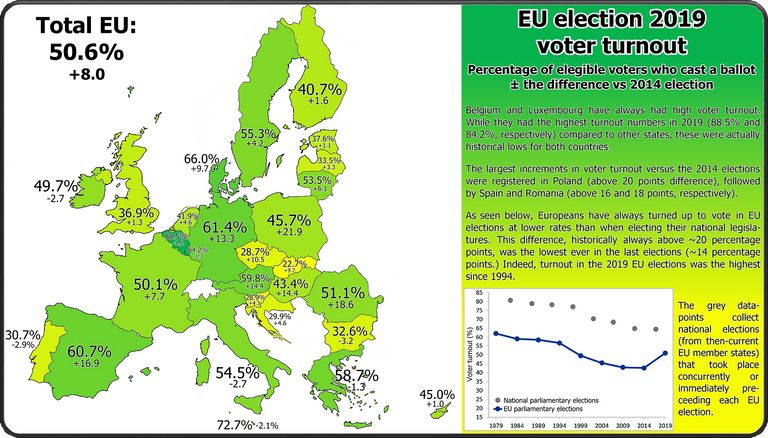
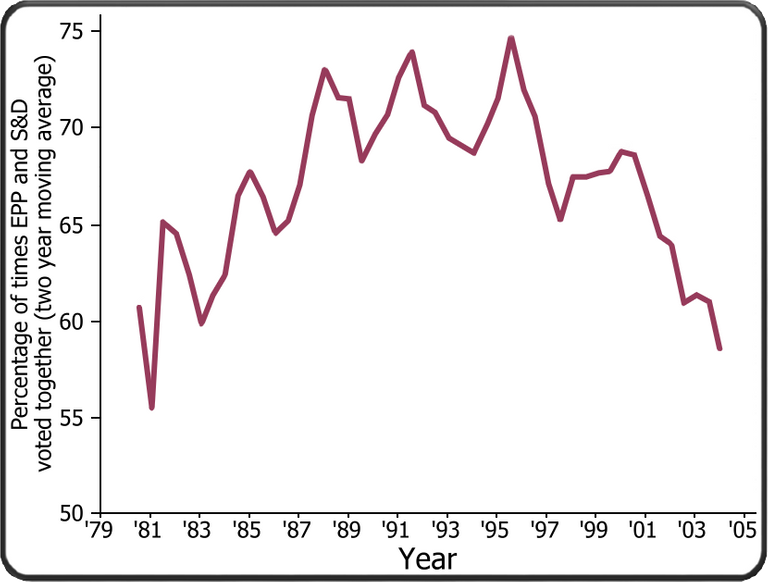
European groups don't leverage their power to form government after an election, as it usually happens in parliamentary democracies, but rather vote to elect the President of the European Commission (who is first nominated by the European Council, itself composed of heads of state/government from all member states plus the President of the European Commission and the President of the European Council. Yeah, be thankful I'm not going to detail all the intricacies of EU political organization). The EP also elects the President of the European Parliament every 2.5 years, meaning at the beginning and halfway through each parliamentary term. Historically, the S&D and the EPP have usually backed each other's candidate for each half (see Figure 2 for the full picture of this "grand coalition").
MEPs that don't join any group are known as "non-attached" but teaming up grants MEPs/parties many advantages. Other than obviously being able to leverage more political power, there are other perks in joining a group such as increased funding, more speaking rights and guaranteed membership in committees. Currently, to be recognized as a group you need to pull together at least 25 MEPs from at least 7 countries.
(TLDR News has a short video explaining some of the EU basics too if you want more.)
Parliamentary Groups (up to the 2019 elections)
The main two blocs are the "socialists" and the "conservatives," which have always been the two largest groups since the first elections held in 1979. The Progressive Alliance of Socialists and Democrats (S&D) or "socialists" are the pro-EU centre-left neoliberal group, socialists in name only and social democrats at best. The conservatives form the European People's Party (EPP), the pro-EU centre-right neoliberal group, historically Christian democrats. The EPP has held a plurality over the S&D since 1999 but the two have been historically in cahoots because together they always had supermajority... that is until the 2019 elections as we will see later. Dun dun duuuuuuuun.
Sandwiched between the EPP and the S&D we find the third-largest group, the Alliance of Liberals and Democrats for Europe (ALDE) or "liberals," who are the pro-EU centrist neoliberal group (Emmanuel Macron's En Marche! joined this group for the 2019 elections).
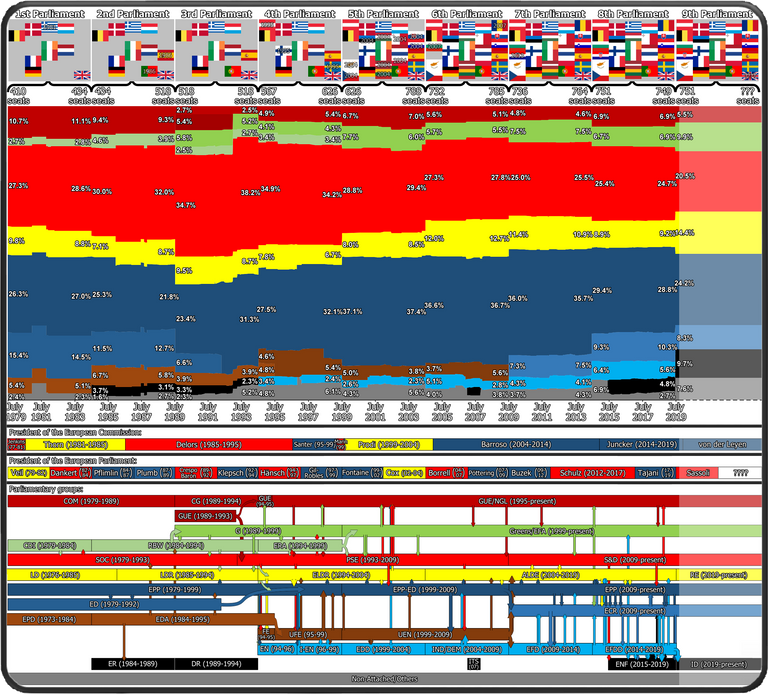
On the left we have the European United Left–Nordic Green Left (GUE/NGL) and the Greens–European Free Alliance (Greens/EFA). The GUE/NGL group is the "far-left" bloc composed of actual socialists and communists who have a left-informed (ie. anti-capitalist, anti-neoliberal) soft Euroscepticism. The Greens/EFA group is formed by the ecologists (European Green Party), regionalists (European Free Alliance) and pirates (European Pirate Party). This group grew out of a more eclectic collection of parties, but by now it has shed the more right-wing elements and can also be considered to be generally pro-EU.
If we move towards the right we have the European Conservatives and Reformists (ECR), the Eurosceptic centre-right to right-wing neoliberals (founder David Cameron may sound familiar to you). This group is largely a reformation of the European Democrats (ED) which had joined forces with the EPP between 1992 and 2009. And as we get to the xenophobia and hard Euroscepticism of the far-right we first find the colourful fellas from Europe of Freedom and Direct Democracy (EFDD) which is the more Trumpian-esque (you may recognize Brexiteer extraordinaire Nigel Farage) group and finally the Europe of Nations and Freedom (ENF) group which is where the fascists that somewhat try to keep their masks on roam (Marine Le Pen should ring a bell).

2019 Elections
The 2019 elections were marked largely by two issues: Brexit and the rise of the far-right. Brexit was supposed to happen before the elections, but we all know that mess will be unwinding for some time still (the next deadline is 31 October 2019 and I can't wait for Boris Johnson to fail miserably). As for the rise of the far-right, let's see what happened.
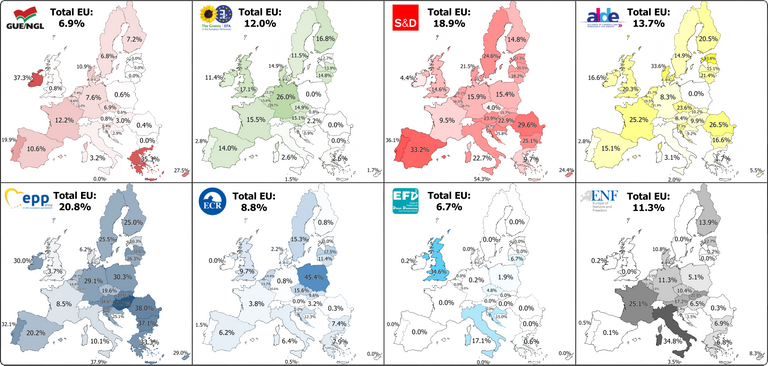

The Winners
ALDE had a good election: it gained 39 MEPs and with EPP+S&D losing their supermajority, it has a lot more say at the parliamentarian table. Most of those extra MEPs come courtesy of Macron's En Marche!, which is now the largest party within the group, making the French president a de facto leader (the other major gain comes from the UK's LibDems, which may or may not Brexit). In fact, the group rebranded itself as Renew Europe (RE) after Macron's party joined, because neoliberalism is apparently something new.
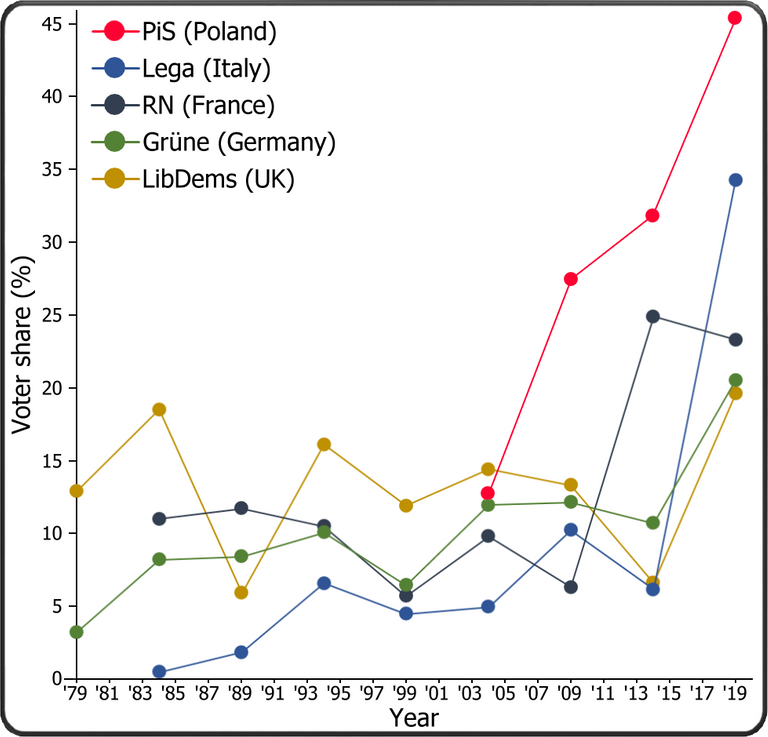
The far-right also had a good night, sadly, gaining 37 seats (effectively doubling in size). With this, the ENF rechristened itself Identity and Democracy (ID) and de facto leadership can be said to have gone from Le Pen to La Lega's Matteo Salvini. Italy's deputy Prime Minister (who formed government with Movimento 5 Stelle back home in 2018) commanded a solid plurality of the Italian vote and cemented Lega as a real national alternative, outgrowing its Northern Italy's roots and (bigoted) focus. Before the elections, Salvini set out to unify and build a solid far-right in the EU (with a certain American buzzing around) and it was feared/hoped that the group would end up with even larger gains. While his wet dream didn't fully materialize, this is the largest group the far-right has managed to agglutinate inside the EP, big enough to prompt the other groups into establishing a cordon sanitaire. We will now have to wait and see if anti-EU sentiments and xenophobia are enough to keep it together (other than competing nationalisms, some parties are pro-Russia, others anti-Russia). The previous far-right group, Identity, Tradition, Sovereignty (ITS), collapsed after less than a year when Alessandra Mussolini (yes, that Mussolini) made xenophobic/bigoted remarks against Romanians... prompting Romanian members to leave the group. To paraphrase a well-beloved author: it's not love that unites them, but sheer horror.
On the more uplifting side of things, the Greens/EFA group gained 22 seats to become the fourth largest in parliament. Around half these gains came from Germany where for the first time the Grüne party obtained more votes than the SPD.
Finally, I would point to Ursula von der Leyen, who was narrowly voted in as President of the European Commission, as another winner. This Merkel protege comes from a very wealthy family of politicians and as I understand she is seen as something of a joke back home. She likes to talk about European federalism and has also brought forward the idea of a European Army.
The Losers
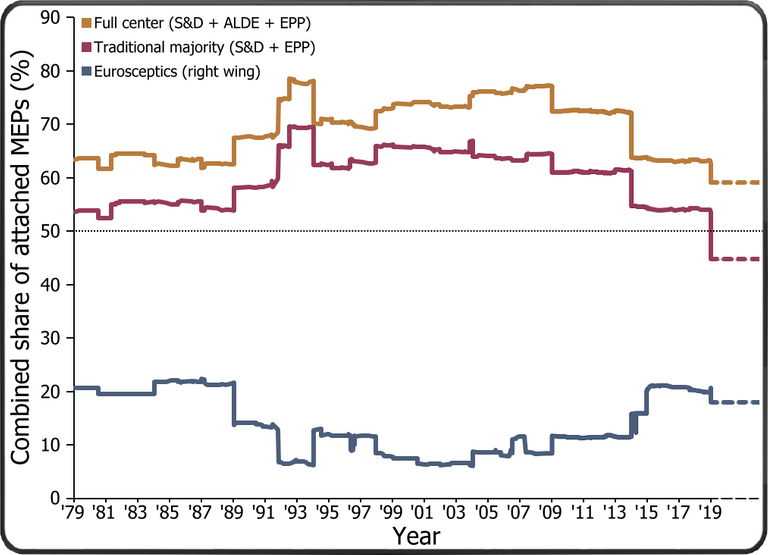
Both the EPP and the S&D lost more than 30 seats each. Some media outlets reported after analysing the election that centrist parties lost but I think that framing is slightly wrong. In fact the centrist group, literally, was one of the election winners. I think the actual lesson to take home is that the traditional parties are the ones that lost, for the first time they have lost their historical combined majority (see Figure 7).
People are tired of those who have been pushing neoliberalism and the third way down our throats, we may not know exactly what the problem is but we certainly know the parties that have been ruling over us taking turns for the last 40 years. We have seen this in America with the rise of outsiders and/or anti-establishment types like Trump and Bernie Sanders. We have seen this across Europe too in countries like France (Macron and Le Pen4), the UK (Farage and LibDems), Italy (Salvini and Movimento 5 Stelle) or Spain (Podemos and Ciudadanos). After decades of neoliberal failure, the chicks have come home to roost and the traditional parties are falling by the wayside (see Figure 8 below).
The ECR lost 15 seats but these come from basically two sources. Alternative für Deutschland joined Identity and Democracy and the Tories were so badly slaughtered these elections that they went from being the second-largest member with 19 MEPs to now holding just a meagre 4 seats. Special kudos 'cause it was David Cameron that launched this group! Anyway, considering the (impending?) Brexit, this is not too bad for ECR, they may have largely just shed dead weight.

The Big Losers
The EFDD was the big loser: it has ceased to exist, it's an ex group. To be fair, the group's continued existence was already tenuous when its largest member, Farage's UKIP/Brexit party, was initially set to Brexit even before the elections. With most other members failing to get re-elected or bailing, the fate of the group was sealed. Special mention goes to the group's second most important member party, Italy's Movimento 5 Stelle, which had been fishing around to join a different group but got nothing but rejections. I guess that happens when you are a collection of people with no unified ideology and allied yourself with Nigel Farage.
Speaking of whom, while Farage may have lost the power to make demagogue grand standings in the EP, he did score a victory back home obtaining more than 30% of the vote and catapulting the implosion of the Conservative Party. Some were happy to stack all the supposedly "Remain" vote and see the glass half full (you can see how those stacks would look here), but in a world were Nigel Farage obtains a solid plurality, the glass isn't half full or half empty, it's overflowing with shit.
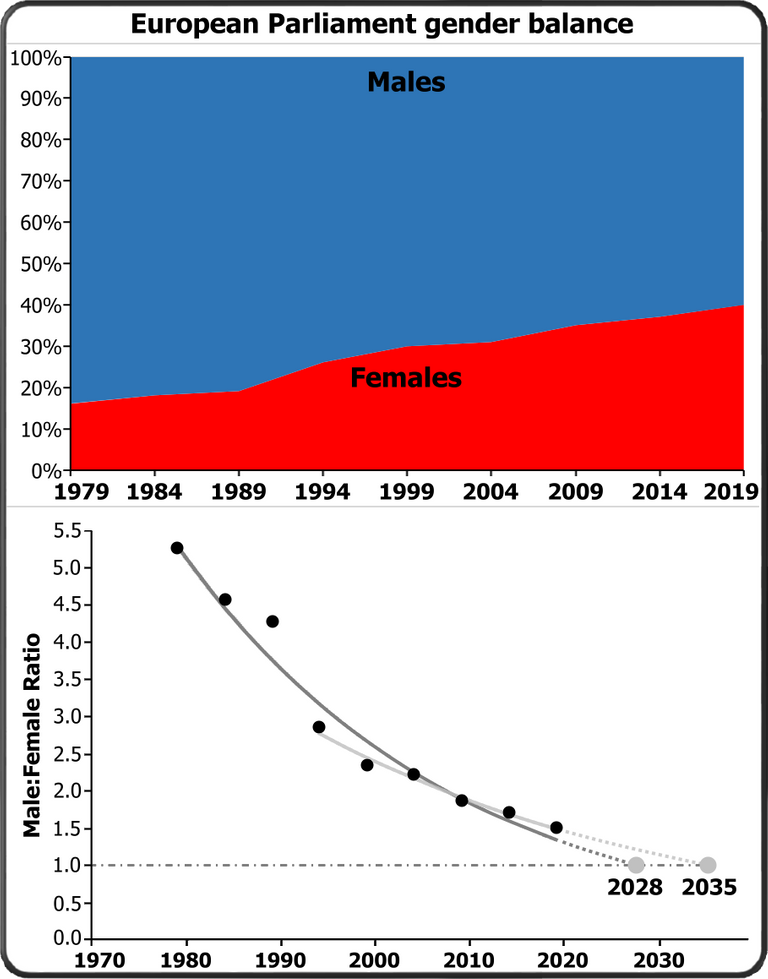
Gender parity
I guess we can use gender balance as a way to roughly assess progress, and things have been progressing. In 1979 there were 5.25 male MEPs per each female one, a number that has been going down since then and now stands at 1.5 (see Figure 9). Interestingly, the EP has been more gender-balanced than the corresponding national parliaments throughout its entire existence. You can also see a breakdown by member state here.
If we assume there's an exponential trend and it keeps up, then we could maybe expect gender parity to be reached around the 2029 or 2034 elections...
...and complete female takeover sometime in, like, the 2100s MUAHAHAHAHA.
Notes
#1. Fun fact: It’s also the only supranational entity whose members form groups according to ideology instead of nationality.
#2. COM = Communist and Allies Group. CG = Coalition des Gauches (Left Unity). GUE = Groupe de la Gauche Unitaire Européenne (Group for the European United Left). NGL = Nordic Green Left. By the late 70s, most European socialists and communists had been moving right towards the "respectable" centre-left. The COM group had been founded in 1973 and split into CG (pro-USSR communists) and GUE (Euro-communists) in 1989. The final blow came in 1993 when the Italian Communist Party (Partito Comunista Italiano, PCI) became the Democratic Party of the Left (Partito Democratico della Sinistra, PDS) and joined the PES. With this, the GUE collapsed. CG was joined by GUE leftovers and reformed into a new GUE in 1994 and with the expansion of the EU in 1995 it was joined by the NGL (Danish, Finnish and Swedish parties). Today, the GUE/NGL group is a majority democratic socialist group associated with these major European parties: Party of the European Left, European Anti-Capitalist Left, Now the People!, Nordic Green Left Alliance and Animal Politics EU.
CDI = Groupe de la Coordination Technique pour la Défense des Groupes et Membres Indépendants (Technical Group of Independents), RBW = Rainbow Group, G = Green Group, ERA = European Radical Alliance, EFA = European Free Alliance. This all started in 1979 with an eclectic group of non-aligned parties, mostly regionalists and far lefties, who got together I suppose to try and have more weight inside the EP. By 1981 the regionalists had created their European party (EFA). The group evolved into RBW when green parties entered the EP in 1984 (they had failed to in 1979), but ideological differences led to the Greens splitting away in 1989. In 1994 the regionalists had a poor election (on top of Lega Nord being suspended from the group) and joined forces with Italian Lista Pannella and the French party Energie Radicale to form the ERA group. Poor electoral performance led ERA to join with the Greens in 1999 to form the Greens/EFA group. Main European parties associated with the group are the European Green Party, the European Free Alliance, the European Pirate Party, Animal Politics EU and newcomers Volt Europa.
SOC = Socialist Group, PES = Group of the Party of European Socialists, S&D = Progressive Alliance of Socialists and Democrats. Founded in 1953, this was one of the original three groups (together with the liberals and the conservatives) and has been the most consistent in terms of membership. Associated with the Party of European Socialists.
LD = Liberal and Democratic Group, LDR = Liberal and Democratic Reformist Group, ELDR = Group of the European Liberal, Democrat and Reform Party, ALDE = Alliance of Liberals and Democrats for Europe, RE = Renew Europe. Founded as the Liberals and Allies Group in 1953, the group has gone through several renamings as different parties joined or left. The main European parties associated with the group are the Alliance of Liberals and Democrats for Europe Party and the European Democratic Party.
EPP = Group of European People's Party (Christian Democrats), ED = European Democrats, EPP-ED = Group of the European People's Party (Christian Democrats) and European Democrats, ECR = European Conservatives and Reformists Group. The EPP was founded in 1953 as the Christian Democratic Group and was the largest group until 1979 and again from 1999 to the present. ED was founded as the European Conservative Group in 1973 and grew to be the third-largest group in the EP until 1989 when a lot of member parties defected to the more EU-phile EPP. The UK's Conservative Party was basically left alone in the group (plus two MEPs from the Danish and fellow founding member Konservative Folkeparti) and by 1992 the decision was made to just join the EPP, although it never fully integrated and remained as a more Eurosceptic subgroup. In 1999 the Tories, then under the leadership of David Cameron, were able to once again form an independent group, the ECR. The European People's Party forms the EPP group in the EP, the Alliance of Conservatives and Reformists in Europe party forms the ECR, and the European Christian Political Movement party is associated with both.
EPD = Group of European Progressive Democrats, EDA = Group of the European Democratic Alliance. Founded in 1965 as the European Democratic Union by Gaullists who split away from the Liberal Group, it changed name to EPD in 1973. It was again renamed in 1984, this time to EDA, when the Irish Fianna Fáil joined and became the second-largest party in the group. FE = Forza Europa, UFE = Group Union for Europe, UEN = Union for Europe of the Nations. FE was centred around Berlusconi's Forza Italia party and only ever had Italian MEPs. It existed for a single year before merging with all members from EDA (French Rassemblement pour la République, Irish Fianna Fáil, Portuguese CDS – Partido Popular and Greek Πολιτική Άνοιξη) to form UFE in 1995. With this, UFE became the third-largest group in the EP for a 3-year period. The group had to adapt to survive when its largest members (the Gaullists and Forza Italia) left to join EPP and rebranded itself UEN for the 5th Parliament, now joined most importantly by Eurosceptic Gaullists (Rassemblement pour la France) and the Italian Alleanza Nazionale. By 2009 Fianna Fáil had decided to join ALDE, Alleanza Nazionale merged with EPP's Il Popolo della Libertà and the remaining parties decided to move on to ECR or EFD.
EN = Europe of Nations Group (Coordination Group), I-EN = Independents for a Europe of Nations, EDD = Group for a Europe of Democracies and Diversities", IND/DEM = Independence/Democracy, EFD = Europe of Freedom and Democracy, EFDD = Europe of Freedom and Direct Democracy. EN was founded in 1994 as the first parliamentary group centred around Euroscepticism, which always remained the focus as the group went through many reformations through the years. As leader of UKIP, Nigel Farage became chair of the group (together with Lega Nord's Francesco Speroni) when it reformed as EFD with members coming from UEN in 2009. Farage remained chair (with Movimento 5 Stelle's David Borrelli) as the 8th Parliament took shape, but the group suffered too many loses in the 2019 elections and is now disbanded. The main European party associated with the group was the Alliance for Direct Democracy in Europe, which imploded back in 2017 when an audit revealed misspending of funds.
ER = Group of the European Right, DR = Technical Group of the European Right, ITS = Identity, Tradition, Sovereignty, ENF = Europe of Nations and Freedom, ID = Identity and Democracy. The fascist groups in the EP have always been organized around Jean Marie Le Pen's Front National. In 1984 he created ER together with Italy's Movimento Sociale Italiano and Greece's Εθνική Πολιτική Ένωσις, but in-fighting between German and Italian MEPs led to the collapse of the group as the 3rd Parliament was taking shape. So Le Pen founded DR together with the German Republikaner and the Belgian Vlaams Blok only to be dissolved following poor performance in the 1994 elections. The far-right didn't manage to have a group inside the EP again until the 2007 EU enlargement. ITS was again centred on the Front National plus parties from Italy, Belgium, Austria, Romania and Bulgaria, but barely lasted ten months before self-destructing. In 2015 the Front National, now under the leadership of Marine Le Pen, once again rallied the far-right nationalists together into ENF, and after the 2019 elections the group has grown (now with Italian leadership) and rebranded itself ID.
#3. The UK is easy, vote has been split between the Conservative Party on the centre-right and the Labour Party on the centre-left. Similarly in Germany, the centre-right has been dominated by the Christian Democratic Union of Germany-Christian Social Union in Bavaria alliance (Christlich Demokratische Union Deutschlands and Christlich-Soziale Union in Bayern; CDU-CSU) and the centre-left by the Social Democratic Party of Germany (Sozialdemokratische Partei Deutschlands; SPD). In Spain, things have also been relatively simple with the Spanish Socialist Workers' Party (Partido Socialista Obrero Español; PSOE) capturing the centre-left vote and the People's Party (Partido Popular; PDP-AP alliance until 1989) capturing the centre-right vote.
French vote has been split among three different parties. The Socialist Party (Parti Socialiste) on the left and two parties on the right: Rally for the Republic (Rassemblement pour la République; evolved into the Union pour un Mouvement Populaire between 2002-2015 and then into Les Républicains) and the more centrist Union for French Democracy (Union pour la Démocratie Française; succeeded by the Mouvement Démocrate since 2007, which has all but collapsed by now).
In Italy things have been more complicated. In the 80s vote was split between three parties: the Christian Democracy (Democrazia Cristiana) on the centre-right, the Italian Socialist Party (Partito Socialista Italiano) on the centre-left, and the Italian Communist Party (Partito Comunista Italiano) on the more proper left. As the years went by the two left-wing parties went through a lot of splitting, alliances and mergers while Christian Democracy collapsed in the early 90s as Berlusconi captured the right to centre-right space, so I kept in all these left-wing parties and Berlusconi's parties for the calculations.
#4. Jean-Marie Le Pen had also previously risen enough to challenge the French establishment in 2002, but he only achieved a fraction of the support his daughter got in 2017.
Read more
"European Parliament: Facts and Figures (2014-2019)" by the EU.
"Democracy in the European Parliament" by Simon Hix.
"4 factors driving anti-establishment sentiment in Europe" by Pew Research Center.
You just planted 0.09 tree(s)!
We have planted already
6847.14 trees
out of 1,000,000
Let's save and restore Abongphen Highland Forest
in Cameroonian village Kedjom-Keku!
My Steem Power = 24691.46
Thanks a lot!
Thanks to @tychoxi Plant trees with @treeplanter and get paid for it! @martin.mikes coordinator of @kedjom-keku
Congratulations @tychoxi! You have completed the following achievement on the Steem blockchain and have been rewarded with new badge(s) :
You can view your badges on your Steem Board and compare to others on the Steem Ranking
If you no longer want to receive notifications, reply to this comment with the word
STOPCongratulations @tychoxi!
You raised your level and are now a Minnow!
Congratulations @tychoxi! You received a personal award!
You can view your badges on your Steem Board and compare to others on the Steem Ranking